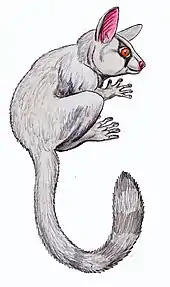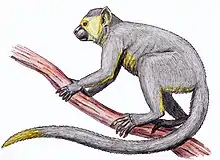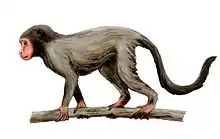| Nyanzapithecus Temporal range: | |
|---|---|
 | |
| Scientific classification | |
| Domain: | Eukaryota |
| Kingdom: | Animalia |
| Phylum: | Chordata |
| Class: | Mammalia |
| Order: | Primates |
| Suborder: | Haplorhini |
| Infraorder: | Simiiformes |
| Family: | †Dendropithecidae |
| Genus: | †Nyanzapithecus |
| Species: | †N. pickfordi |
| Binomial name | |
| †Nyanzapithecus pickfordi | |
Nyanzapithecus pickfordi is an extinct species of primate from the Middle Miocene of Maboko Island, Nyanza Province, Kenya.[1] It had an average body mass of around 10 kg (22 lb).[1][2]
Taxonomy
Fifteen cranio-dental specimens of this species were collected from the island between the years 1933-73.[3]
During an expedition to Maboko Island in 1982–83, paleoanthropologist Martin Pickford recovered more than a hundred small catarrhine fossils. Among them, Harrison 1986 described the new genus and species Nyanzapithecus pickfordi, characterized by several dental specializations, and also transferred the Rangwapithecus species R. vancouveringi to the genus renaming it N. vancouveringorum. Nyanzapithecus was considered closely related to Rangwapithecus and Mabokopithecus based on dental similarities, and an early relative of Oreopithecus bambolii. Nyanzapithecus was originally included in Oreopithecidae before being transferred to Proconsulidae. Kunimatsu 1997 described a new species, N. harrisoni, from Nachola, Kenya.[4]
Benefit et al. 1998 considered Mabokopithecus clarki congeneric and even conspecific with N. pickfordi and thus renamed the latter Mabokopithecus pickfordi/clarki and Kunimatsu's species M. harrisoni.[5]
Dental morphology
Nyanzapithecus pickfordi has a dental formula of 2:1:2:3 on both the upper and lower jaw. The upper premolars were long and had buccal and lingual cusps which resembled each other in size the lower molars had deep notches. Based upon dental morphology this was a folivorous species.[1][2]
Notes
- 1 2 3 Fleagle 1988
- 1 2 "Nyanzapithecus pickfordi". The Primata.
- ↑ Harrison 1986
- ↑ Harrison 2002, p. 313
- ↑ Tuttle 2006, pp. 23–4
References
- Benefit, BR; Gitau, SN; McCrossin, ML; Palmer, AK (1998). "A mandible of Mabokopithecus clarki sheds new light on oreopithecid evolution". American Journal of Physical Anthropology. 26 (Suppl) (S26): 109. doi:10.1002/(SICI)1096-8644(1998)26+<100::AID-AJPA8>3.0.CO;2-7.
- Fleagle, JG (1988). Primate Adaptation and Evolution. New York: Academic Press. ISBN 9780122603402.
- Harrison, T (1986). "New fossil anthropoids from the Middle Miocene of East Africa and their bearing on the origin of the Oreopithecidae" (PDF). American Journal of Physical Anthropology. 71 (3): 265–84. doi:10.1002/ajpa.1330710303. PMID 3101504.
- Harrison, T (2002). "Late Oligocene to middle Miocene catarrhines from Afro-Arabia" (PDF). In Hartwig, W (ed.). The Primate Fossil Record. Cambridge University Press. ISBN 978-0-521-66315-1.
- Kunimatsu, Y (1997). "New species of Nyanzapithecus from Nachola, northern Kenya". Anthropological Science. 105 (2): 117–41. doi:10.1537/ase.105.117. ISSN 0918-7960.
- Tuttle, R (2006). "Seven Decades of East African Miocene Anthropoid Studies". In Ishida, H; Tuttle, R; Pickford, M; Ogihara, N; Nakatsukasa, M (eds.). Human origins and environmental backgrounds. Developments in Primatology: Progress and Prospects. Springer. p. 23. ISBN 978-0-387-29638-8.



